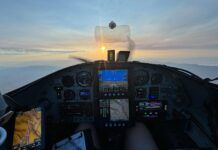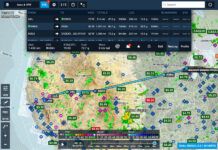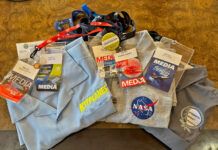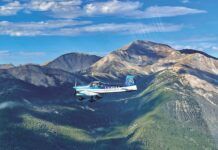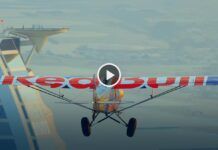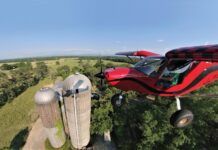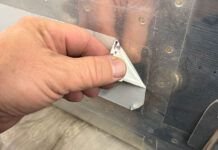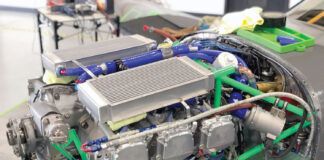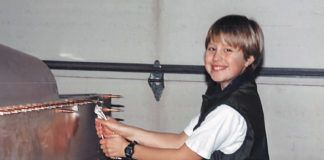“Commitment is nothing more than asking the same question (and having the same answer) over and over: What do I really want?”
—Michael Maya Charles, Artful Flying.
After three years of building our most recent project, I believe that my husband and I can safely say that we meet Charles definition of commitment. The first page of our Vans RV-10 builders manual is like a flashback in black and white. Project start: 11/09/04. Flight-plan designation: HXB. It represents three years of investing in tools including a new air compressor-a big one-a bevy of drill bits, hand squeezers, dozens upon dozens of different kinds of Clecoes…the list is nearly endless. The total invested in materials with which to work the materials was around $1400.
All that to take flat-packed crates of pre-drilled aluminum and transform them into our mid-marriage, midlife crisis machine.
Depends on Who You Ask
If you ask him, my husband will tell you point blank that the whole thing, all of it, is my fault. After all, it was I, back in 2004, who craved an all-glass cockpit. Im the one who did the math and realized that it was never going to happen with our 25-year-old Cessna 182. No, what we needed, I was convinced, was a new airplane, with a new panel. The only way we could have it on our budget was by building it.
“We can do it,” I said, squinting at the Vans Aircraft web site, holding a recent copy of an RV-10 flight review. My husband, always the diplomat, retorted, “What We? I get to build you the airplane you want? That We.
Sheepishly, I replied, “Ill help.”
“Yeah, right,” he mumbled. It would take a little more than my affirmation of assistance to bring him around.
What had held him back was experience. Our first kit aircraft, a Kitfox IV, was built when our children were infants. He had the construction knowledge to build the tube-and-rag airplane with its basic electrical system. I kept the kids alive and made sure he ate on occasion. It took only nine months and 1000 hours.
The RV, I knew, was a whole other animal. With its complexity and size, I figured it would take three or four times as long to fabricate and assemble. The difference with this project, though, was that this time I could help. The kids are teens now, and, hey, even they could help! The transformation of the flat-packed CNC punched sheet metal and rivets into three-dimensional aircraft parts was a project designed for more than two hands, and mine were willing and ready to go to work.
Primed and Ready
The weekend before the holidays that year the rudder began to take shape. First we fitted the parts together to see if the factory-punched holes lined up. They did. The air compressor hummed, punctuated by the occasional blast from the air drill as my husband drilled each CNC-punched hole by hand. After match-drilling each part and its components to its final dimension, that part had to be disassembled and the skin dimpled. Dimpling is Vans preferred method of providing for flush rivets on thin aluminum skins, because countersinking grinds away metal, compromising the strength of the bond.
Each time we finished fabricating and fitting the parts my husband broke out the sprayer and respirator, draped all adjoining areas of the hangar with plastic tarps, and then primed every interior aircraft component with a self-etching primer. Through these stages in the building process the project was really just a giant Erector set, but that, of course, was just the beginning.
Then we started riveting. I learned not just how to buck, but also which bucking bar to use. I learned when you need a hand-squeezer and about the different kinds of rivets and where and when to use each. I learned about oversized rivets, perfect for when the hole gets a little bigger than originally planned (for example, when the bucking bar slips and the rivet back comes out uneven and has to be drilled out completely-oops!). My small hands and relatively petite frame have proved perfect for bucking in tight corners and on awkward curves.
Real Progress
By early February 2005 we had the entire empennage assembled, sitting on two sawhorses. The rudder waggled. The elevators waved. Sure, the end caps were missing and the trimtabs had yet to be fitted, but there it was, the back half of our airplane, no longer a flat pack of aluminum parts. We were amazed and motivated. Wed only just ordered the fuselage kit. Unfortunately, it would be June before we could get to work on the wings and the fuselage. By then the summers heat was daunting, and things went slowly. But progress was made.
A year went by, full of trimming and fitting and finishing the seeming never-ending task of the fiberglass canopy and doors, and we were thinking about firewalls. There were discussions, long, exhausting debates and lots of research, but by Sun n Fun 2006, it had become obvious there was no alternative engine that we were confident enough in or could afford, and at that show we put a deposit on a rebuilt IO-540 Lycoming that had come off a storm-damaged Piper Aztec. Then we ordered the firewall-forward and finishing subassembly kits from Vans.
While we were at that show, we also were turned on to Sam James Holy Cowl, wheelpants and his son Wills plenum. We loved the looks, the finish and the potential for better airflow, and we went with it.
At AirVenture we committed to avionics, again after much heated debate. I compromised on my dream panel, but not much. SteinAir was commissioned to assemble the combination of a Garmin GNC 300XL, a GTX 327 transponder and SL30 nav/com and dual Grand Rapids Technology EFIS instrumentation into a mostly pre-wired, pre-assembled panel. We settled on an interior design and hired Flightline Interiors to make the seat covers. By summers end the airplane-and that is what it looked like now-had an engine permanently hung, and it was standing on its own three wheels.
That was more than a year ago, I realize, as I shuffle through the pictures, trying to pick the best for our builders log. There’s been a lot more fiberglass work since then, cutting in the windows and the canopy to make them perfectly smooth, trimming and priming the cowls, and then doing it again after a few James modifications. It was nine months waiting on the instrument panel and wiring, and in the interim every fiberglass piece on the airplane, from fairings to cuffs, from tips to wheelpants, was made ready for final paint. We even picked out a design and colors, with some help from Craig Barnett of Scheme Designers (though we are still arguing over when to do the painting-before or after first flight).
Once the panel showed up its been all about the electrics. Snaking fat main wire bundles through what had once seemed entirely adequate conduit under the permanently riveted floor and seat panels kept us busy for days, as did the fabrication of the many specific pins and bundles for each complicated connector necessary to make the shiny EFIS/MFD screens strut their stuff. Im still waiting to see them light up for the first time, but its coming.
Anticipation
Not long ago I watched my neighbor fire up his Glasair III, seven years in the making, for the first engine run. His Lycoming IO-540 belched white smoke and coughed, and then roared to life. I knew he had weeks of work ahead of him before the plane would fly, but the noise gave me goosebumps.
Now I look over at our “pile of bolts” and realize that we are well on our way to that same thrilling moment. It wont be long, I coo to it, as one might to an anxious child watching his older sibling walk through the school gates. The metal, with its carefully preserved Alclad coating, just shines back at me, a little cold, a little sparkly in the early winter light. I pull my rings and watch off and set them in a bowl on the back corner of the workbench. I hear the door slam to the main house and watch as my husband, still the “builder,” heads my way. Time for work.

